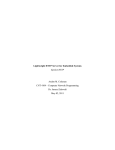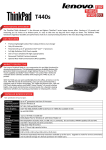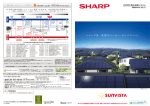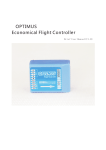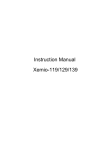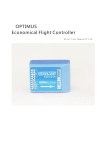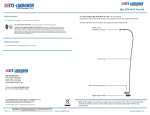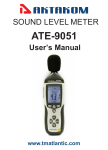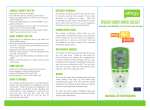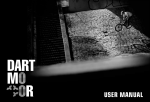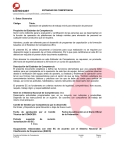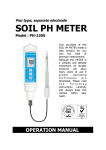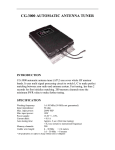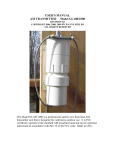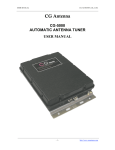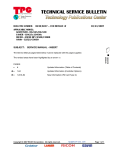Download CONTEST 2002
Transcript
HF/VHF AUTOMATIC PLL SYNTHESIZED ARDF TRANSMITTER CONTEST 2002 instruction manual INTRODUCTION The first PLL synthesized fully programmable ARDF transmitter is designed for any level of ARDF competition or training. The possibility of frequency adjustment opens the new area in the ARDF competitions and allows using more transmitters on different frequencies. All parameters are widely adjustable via user-friendly menu, settings are stored in EEPROM memory. After features are set, the operation is very easy: just install the antenna, plug in the connector and transmitter automatically recognizes the proper band and starts operation. If antenna is disconnected, the trasmitter turns to the STANDBY mode (only 2 mA consumption) and after 30hours, turns off itself. The accumulator is internally protected against deep discharge and its status is indicated at the end of every relation. For training purpose, you can use the transmitter without the external accumulator ( its weight will be then less than 1 kg). Rugged, waterproof aluminum house protects the transmitter against the environmental influences, anti-theft loop with cable lock protects it against stealing. TABLE OF CONTENTS INTRODUCTION IMPORTANT PRECAUTIONS TABLE OF CONTENTS UNPACKING 1 2 IMPORTANT! Read this instruction manual carefully before attempting to operate the transmitter. Save this instruction manual. This instruction manual contains important safety and operating instructions for the CONTEST2002. 3 PANEL DESCRIPTION Top panel Front panel Front panel display INSTALLATION Unpacking Before operating Switching on MODE selector Clock synchronizing 3,5 MHz antenna installation 144 MHz antenna installation Switching off 4 PARAMETER SETTING General Code and keying speed Timing schedule Frequency Power 5 MAINTENANCE Fuse replacement Charging Cleaning 6 TROUBLESHOOTING 7 SPECIFICATIONS 8 TECHNICAL INFORMATION 9 OPTIONS 10 WARRANTY, SERVICE OTHER FEATURES Supply External accumulator Band selecting PRECAUTIONS ! NEVER ! NEVER AVOID apply AC or more than 16V DC to any socket of the transmitter. This may cause fire or ruin the transmitter. use any charger except for the one supplied by the manufacturer. You may ruin the accumulator or even the whole transmitter. using or placing the tranmitter in the areas with temperatures below -20°C or above +60°C. Use only accessories supplied by the manufacturer.. UNPACKING Accessories included with the CONTEST2002: - antenna and counterpoise for 3,5 MHz band - antenna and 2+2 elements for 144 MHz band - external accumulator 12V/2,6 Ah. - carrying case - fuse F4A (2 pcs) - this manual 1 Front panel display: PANEL DESCRIPTION START STOP Top panel: 3,5 MHz antenna tuning anti-theft loop external accumulator connector mode selector 12 12 12 12 contest 2002 12 12 12 12 12 12 12 12ACCU ANT 12 12 12 12 ARDF TX accu. voltage indicator antenna/charger/sync. cable connector 1:08 MOS 60/240 MODE REL Push to turn the transmitter ON. After turning on, the display shows clock (in 5-minute cycle), code and timing schedule Pushing UP/DOWN buttons, you can go through all menu items and check all transmitter settings: CONT STBY SET 1234567 1234567 12 12 1234567 1234567 12 ok2bwn 1234567 1234567 RADIO SPORTS EQUIPMENT CODE:MOS SPD: 50 - transmitted code (MOS) - keying speed (50 PARIS) T:60/240 ST:0+120 - timing schedule (60s transmit, 240 s space) - relation start (120s after 0:0) f: - 80m frequency (3,52 MHz) - 2m frequency (144,50 MHz) on air indicator Front panel: display 1:08 MOS 60/240 processor reset ENTER button (enters SET mode, only while MODE selector in the SET position) UP/DOWN buttons (browse through menu, change values) ENTER START STOP START button (turns on the transmitter) 3.52 144.50 POWER: HIGH - output power (high) Note: Menu checking has no influence to the transmitter operation, even if it is transmitting. 2 INSTALLATION Unpacking After unpacking, check carefully the transmitter and all accessories included. In the case of any damage do not use the transmitter and contact immediately the manufacturer. Before operating Before the first usage, charge the accumulator for 24 hours. Please, use this time for reading of this instruction manual. Turning the transmitter ON: START STOP Push the START button on the front panel. Clock and basic setting information will appear on the display and the green LED will flash on the top panel. MODE selector Selector has four positions: • SET (setting) - enables settings change and transmitter shutdown. • STBY (standby) - transmitter does not transmit, only logic unit is running. Transmitter enters this state automatically also when no antenna is connected or accumulator is discharged. • REL (relations) - transmitter operates in relations according to the settings and antenna connected. • CONT (continuosly) - transmitter operates continuously according to the settings and antenna connected. Time base synchronization • One transmitter starting Turn on the transmitter exactly at the beginning of the 1st minute of the cycle. • Starting the set of transmitters by means of a synchrocable 1. Turn on all transmitters (see above). 2. Connect grey connectors of the synchrocable to the sockets on top panels. 3. Exactly at the beginning of the 1st minute of the cycle push the button START on the synchrocable. 4. Disconnect the synchrocable from all transmitters. • Running transmitter restart Exactly at the beginning of the first minute push the RESET button on the front panel (by means of ballpoint pen, for example). The rest of the controls may remain unchanged, the transmitter will keep operation as before, only the clock are restarted. 3,5 MHz antenna installation 3,5 MHz antenna consists of a counterpoise (the wire ended by a DIN connector) and the radiator itself (the wire enden by a banana plug). Lay the counterpoise wire on the ground, straight towards the competition starting point. In case of the 3-radial counterpoise, lay the radials to all directions. The radiator shall hang, for instance, from the tree branch. Use the whole length of the radiator if possible. During dry weather, the radiator may lay even on the tree trunk surface. During rain, when the trees are wet, the radiator shall better hang in a free space. Plug the banana plug into the socket at the counterpoise wire and the DIN connector to the socket on the top panel of the transmitter. Avoid close vicinity of large metal objects such as fences, rails or wires, which disturb the electromagnetic field and makes the finding difficult. NOTE: It is advisable to turn the counterpoise once around the tree in order to prevent the plugs against whipping out when the competitor catches the counterpoise wire. Antenna tuning Turn the MODE selector to the CONT position, then tune the antenna by the ANT button. Try to reach the maximum brightness of the indicator. Then eventually turn to the REL position. Do not touch the transmitter house while tuning. 144 MHz antenna installation The 144 MHz antenna consists of an antenna body with cable and four elements (two short and two long). Screw the elements into the antenna body - the shorter ones horizontally and the longer tilted. Hang the antenna on the tree branch by the string tied on the top of an antenna body. The coax cable shall lead vertically down. Install the antenna as high as possible, 3 m at least. Plug the DIN connector to the socket on the top panel. The 144 MHz antenna needs no tuning. The ANT indicator shows only transmitted carrier. Turning the transmitter OFF: 1:08 MOS 60/240 ENTER SHUTDOWN UP+DN! 1. manually: in the basic menu status (clock on the display) push the ENTER button, then push UP and DOWN buttons simultaneously. 2. automatically - transmitter will automatically turn off itself 30 hours after the last start or reset. 3 4 SETTINGS General: Any setting can be changed (or transmitter turned off) only with the MODE selector in the SET position. In other positions, the menu items can be browsed and read only. Settings change: select the wanted menu part by the UP/DOWN buttons, then oush ENTER. Parameter menu will appear, current value flashes and can be changed by the UP/DOWN buttons. Confirm the chosen value by ENTER, which possibly moves you to the next menu item. Settings are stored in non-volatile memory and remain there until they are again user-changed. OTHER FEATURES Supply: The transmitter is supplied by the built-in sealed lead 12V accumulator. As this accumulator is sensitive to the deep discharge, there is two stage protection and telemetric signalisation provided. Under normal conditions (transmitter running, accumulator charged) there is green indicator flashing on the top panel. If the transmitter operates in relations, every relation ends with a long dash showing the normal accumulator voltage. No dash found at the end of the relation means that the accumulator is exhausted and within next 10 to 30 minutes (according to the power and band) internal protection will disable the transmitter in order to prevent the accumulator from deep discharge. The transmitter referee could be warned in advance in order to use spare transmitter or external supply. If the accumulator voltage sinks under 10,3V, the indicator on top panel goes out and the transmitter turns to the STBY mode (see above). After normal accumulator voltage recovers (by connecting the external accumulator, for example), the transmitter continues in normal operation. External accumulator Using the external accumulator will extend the operating period four times. Put the accumulator to the back carrying case compartment and connect it to th esocket on the top panel. External accumulator is charged through the transmitter. Band selecting: The transmitter recognizes connected antenna and selects automatically the appropriate band. If no antenna is connected, the transmitter turns to the STBY mode (regardless of the MODE selector position). Code and keying speed setting: CODE:MOS SPD: 50 ENTER CODE: MOS CODE: MOH ENTER SPEED: 50 ENTER SPEED: 70 Code setting possibilities: MOE, MOI, MOS, MOH, MO5, MO, A...Z. Keying speed setting possibilities: 35, 50, 70, 100 PARIS. Setting the code MOE ... MO5 automatically adjusts the relation position in cycle (see also below). Timing schedule setting: R:60/240 ST:0+120 ENTER TIMING: 60/240 Frequency setting: ENTER TIMING: 30/120 START:0+ 120 f: ENTER 3.52 144.50 ENTER The beginning of the relation can be shifted by any multiple of the relation length along the whole 5-minute cycle. The MOE, MO, A ... Z codes have the default setting +0, it means that the relation begins at the beginning of the cycle. The MOI ... MO5 codes are on default adequately shifted in the cycle. This ofset can be, however, manually changed to any desired value. Resetting the code will reset also the relation ofset to the default. ENTER f 80m: 3.53 START:0+ 180 Timing schedule setting possibilities: 60/240: 60 s transmitting, 240 s space 30/120: 30 s transmitting, 120 s space 30/270: 30 s transmitting, 270 s space 12/48: 12 s transmitting, 48 s space 15/45: 15 s transmitting, 45 s space 30/30: 30 s transmitting, 30 s space 15/15: 15 s transmitting, 15 s space f 80m: 3.52 f 2m: 144.50 ENTER f 2m: 144.55 Možnosti nastavení kmitoètu v pásmu 80m: 3,52 MHz 3,57 MHz 3,62 MHz 3,53 MHz 3,58 MHz 3,63 MHz 3,54 MHz 3,59 MHz 3,64 MHz 3,55 MHz 3,60 MHz 3,65 MHz 3,56 MHz 3,61 MHz 3,66 MHz 3,67 MHz Možnosti nastavení kmitoètu v pásmu 2m: 144,50 MHz 144,67 MHz 145,20 MHz 144,55 MHz 144,75 MHz 145,33 MHz 144,60 MHz 144,85 MHz 145,50 MHz Power setting: VYKON: VYSOKY ENTER VYKON: VYSOKY ENTER VYKON: NIZKY Úroveò výkonu VYSOKÝ odpovídá pøibližnì výkonu 3W v pásmu 3,5 MHz a 3W PEP v pásmu 144 MHz, úroveò výkonu NÍZKÝ odpovídá výkonu 0,9W v pásmu 3,5 MHz a 0,7 W PEP v pásmu 144 MHz. 5 MAINTENANCE Fuse replacement: Either built-in or external accumulators are protected against shortcontact by the fuses o5x20mm, F4A. Replace the blown fuses with the ones of the same value only! Procedure of fuse replacement: 1. Remove 2 screws on the sides of the bottom panel of the transmitter or external accumulator and remove the panel. 2. The fuse position is shown at the pictures: 6 TROUBLESHOOTING The following list is designed to help you correct problems which are not equipment malfunctions. If you are unable to locate the cause of a problem or solve it through the use of this list, contact the manufacturer. After turning on the indicator does not flash but display shows normally Possible cause: exhausted accumulator Solution: recharge the accumulator immediately After turning on the indicator does not flash and display is blank Possible cause: blown fuse Solution: check for possible cause, then replace the fuse Release the fuse holder with a screwdriver (push and turn counterclockwise) and remove it. Replace the blown fuse, put the holder back and secure it by pushing and turning clockwise. 3. Put the bottom panel back and return the screws. Charging The charging period is 1-10 hours according to the discharge level. After the accumulators are charged, the charger automatically switches to trickle charging. The transmitters may remain connected to the charger even a day or two, but not forever. External accumulator is charged through the transmitter, being connected to the socket on the top panel. Keep the accumulators fully charged. Charge them after every competition and also after the longer period of inactivity. Cleaning: Keep the transmitter dry and clean. If the transmitter becomes wet, dry it by the clean cloth and let it dry in a room temperature. Never use strong heaters! If the transmitter becomes dusty or dirty, clean it with a brush or a dry, soft cloth. Avoid the use of strong chemical solvents such as benzine or alcohol to clean the transmitter. The transmitter needs no maintenance above the mentioned procedures. Transmitted signal is distorted or interrupted Possible cause: exhausted accumulator (protection starts activating) Solution: recharge the accumulator immediately or connect the external Transmitter poorly audible (3,5 MHz) Possible cause: antenna not properly tuned or installed, radiator wire whipped out of the socket Solution: check for the antenna installation and/or tuning Transmitter poorly audible (144 MHz) Possible cause: antenna too low or tilted, element(s) lost Solution: check for the antenna installation Transmitter transmits wrong code or in wrong time Possible cause: wrong settings, clock start Solution: check for the settings, restart the clock Transmitter does not respond to controls, does not transmit, strange characters appear on the display Possible cause: microsoftware malfunction, probably in connection with the exhausted accumulator Solution: push the Reset button on the front panel (with the ballpoint, for example). If it will not help, remove the fuse for a while (and disconnect the external accumulator) 7 8 SPECIFICATIONS Top panel connector pin-out: General Supply Operating temperature range Storage temperature range Covering Transmitter: Dimensions Weight External accumulator: Dimensions Weight Operating period (hrs, 3,5-144 MHz) built-in accu only with ext. accumulator TECHNICAL INFORMATION built-in sealed lead accumulator 12V/0,8Ah or external sealed lead accumulator 12V/2,6Ah -10...+ 60°C -20...+ 60°C IP65 80(Wx40(H)x195(D) mm (without projections) 970 g 80(W)x40(H)x195(D) mm 1430 g REL CONT high power 12-17 2-3,5 50-70 10-15 4 144 MHz transmitter Carrier frequency Mode Output RF power @ 50 ohm Spurious emissions: Antenna: 9 channels (144,5 ... 145,5 MHz) A2A, keyed carrier, AM 75% HIGH: 3 W PEP, LOW: 0.7 W PEP less than -60 dB omnidirectional turnstile Logic unit Transmitted codes Keying speed: Timing schedules: Time stability Firmware version: MOE, MOI, MOS, MOH, MO5, MO, A ... Z 35,50,70 or 100 PARIS 60/240 (s, transmit/space), 30/120, 30/270, 12/48, 15/45, 30/30, 15/15 +-10 ppm (approx. 1 s/day) V112GB 3 6 9 7 144 MHz antenna common ground 3,5 MHz antenna 144 MHz band enable 3,5 MHz band enable 12V accumulator reset OPTIONS Automatic charger for 1-6 transmitters Synchro cable Automatic DCF controlled synchronizer Foxoring whip antenna Various transmitting antennas Cable lock REL CONT low power 22-30 4,5-6 90-130 19-27 16 channels (3,52 ... 3,67 MHz) A1A (CW) HIGH: 3 W, LOW: 0.9 W less than -66 dB vertical wire 8 m + 8 m counterpoise 5 1 3,5 MHz transmitter Carrier frequency Mode Output RF power @ 50 ohm Spurious emissions: Antenna: 2 1 2 3 4 5 6 7 10 WARRANTY, SERVICE Should this equipment malfunction under normal use, it will be repaired without charge for a period of one year from the date of purchase. The customer shall not have any claim under this warranty for repair or adjustment expenses if the trouble is caused by improper, rough or careless treatment or mechanical damage, by a fire or other natural calamity or by improper repair or adjustment made by anyone other than manufacturer. The warranty does not cover the accumulators. After the first year of use manufacturer offers the free of charge adjustment and check of the equipment including the recalibration of clock and synthesizer. Any other information, service or modifications are provided by the manufacturer: Jiøí Mareèek, OK2BWN, Obøanská 593, CZ-664 01 Bílovice nad Svitavou phone/fax +420 545227041, e-mail: [email protected] always the right direction ... Jiøí Mareèek, OK2BWN CZ-664 01 Bílovice nad Svitavou, Obøanská 593 phone/fax +420 545227041, e-mail: [email protected] http://www.marecek.sky.cz









